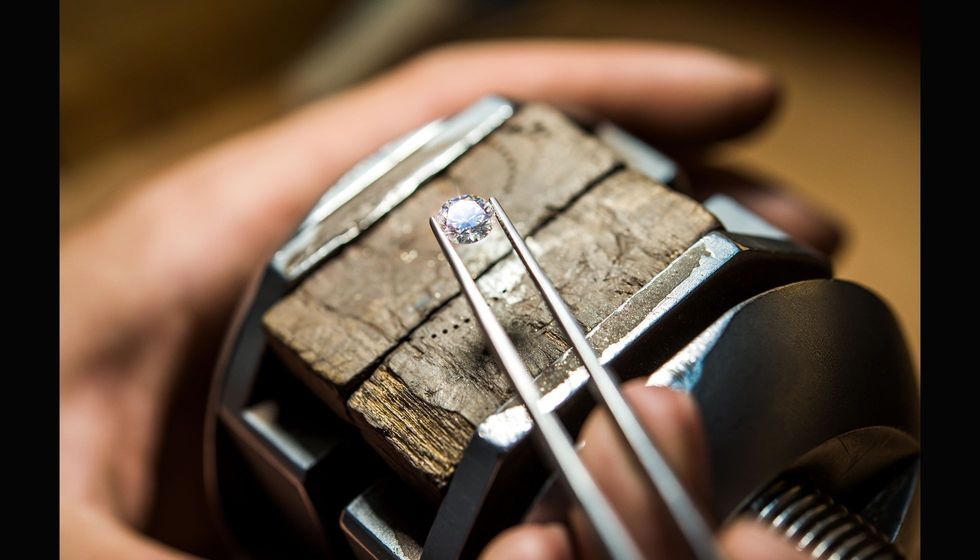Diamonds are one of the most valuable and beautiful gemstones found on Earth!
There are several ways diamonds are formed on Earth. These processes can be natural and made beneath the Earth's surface or synthetic and made in a lab.
Diamonds are indeed formed when carbon is subjected to extreme heat and pressure but there are many types of processes that lead to carbon being made into natural diamonds.
Millions of years ago and 90 mi (150 km) deep below the Earth's surface, diamonds were formed from carbon in conditions of extreme temperatures and high pressure.
Thus, the volcanic activity would have brought these underground deposits of diamonds to the surface through kimberlite pipes. These pipes carry the magma from the mantle of the Earth and when they pass through a zone that contains lots of diamonds, they could also bring the diamonds to the surface along with the magma.
It is quite common for diamonds to be mined in areas that have had volcanic eruptions in the past.
Diamonds can even be found among ocean sediments as well as at impact sites of various asteroids and within meteorites where carbon would have been accidentally put under a lot of pressure and heat.
It is a common misconception that the process of natural diamond formation involves coal.
This is not true as most natural diamonds were formed millions of years before coal could form, and the only element used in their formation is carbon.
The only way coal can be used in diamond formation is when they are developed in a laboratory where lots of energy is used to imitate the conditions of high heat and pressures under which natural diamonds form within the Earth.
Thus, coal is only used in the making of synthetic diamonds when it is used to produce energy.
The first evidence of diamonds being found and mined comes from India almost 2,400 years ago.
Natural deposits for the mining of diamonds have now been found all over the world but the largest producers of diamonds are the countries of Russia, Australia, Canada, as well as many countries in Africa including Botswana, the Democratic Republic of Congo, South Africa, and Angola.
Typically, after diamonds are mined and sorted, 90% of them are cut and polished in China and India, after which they can be sold to retailers for selling in the open market.
The diamond grading system was established by the Gemological Institute of America, which consists of assessing a diamond based on the four C's: cut, color, clarity, and carat weight.
Diamonds, when they get mixed up with other minerals on their way to the surface, can be of many colors such as blue, red, orange, pink, and even yellow!
Wherever their origin, the process of diamond formation remains the same. This is why diamonds can now be formed artificially in laboratories too!
In the beginning, machinery was not able to produce a gem-quality stone but over the years, technology has evolved to form gem-quality synthetic diamonds that can be substituted for natural ones. It is only a misconception that lab-created diamonds are different from natural diamonds as they are very similar, down to their chemical and physical properties.
Diamonds are also used in some industries due to their indestructible nature. Today, around 80% of the world's mined diamonds are used for industrial processes such as sawing and drilling.
If you want to know about the origin of other common things we see in our daily life but never really thought about where they came from, then check out our articles on where do peanuts come from? And where do pine nuts come from?
Where do black diamonds come from?
A black diamond also referred to as carbonado, is quite different from the typical white diamond. This is a natural diamond that is completely black in color but can also be shades of gray.
It is one of the toughest forms of the natural diamond. The origin of this kind of diamond is largely unknown, though several theories regarding how a black diamond would have formed have emerged.
Black diamond is an extremely rare form of diamond, found only in the alluvial deposits of countries such as the Central African Republic in Africa and Brazil in South America. Though it does not have the kind of shine or sparkle that a regular diamond has, its black color and elegance are unique and unmatched.
The name, carbonado, translates from Portuguese to burned or carbonized in.
Initially, it was assumed that black diamonds were formed the same way other diamonds are, that is, deep within the Earth's crust from with the help of carbon atoms being subjected to extreme heat and pressure.
However, the theory was soon disproved and scientists then suggested that black diamonds were formed when the giant meteor or asteroid impacted the Earth almost 66 million years ago and caused the extinction of dinosaurs.
Some others suggested that these stones were formed within the Earth's crust and turned black due to radiation, which would have been stronger billions of years ago.
However, the most interesting theory is that black diamonds were formed in outer space within dying stars, whose fragments would have impacted the Earth almost 2.3 billion years ago at the landmass that contained modern-day Brazil and the Central African Republic at the time.
The landmass would have later split into the continents of South America and Africa as we know them today, and that is why black diamonds are only found in these two regions.
Where do blood diamonds come from?
Blood diamonds are not actually made of blood and are not even red in color. These are regular colorless or white diamonds that are mined in areas that are not under the control of an internationally recognized government or in other words, a war zone.
During the civil wars in many countries in Africa, rebel groups took to diamond mining in their area to finance the insurgency, these countries included the Democratic Republic of Congo, Angola, Sierra Leone, and a few others.
After the rough diamonds were illegally mined from the diamond mines in areas controlled by rebels, they were sold to buyers who would smuggle them to other countries and mix them with legally procured or mined diamonds to be cut and polished.
Thus, after the whole process, there was no way to tell which diamonds being sold in the open market came from which diamond mine of the world. The rebel groups would use the money to buy arms and ammunition, thus causing harm to the civilians in those countries.
Blood diamonds are also often referred to as conflict diamonds.
Where do blue diamonds come from?
Blue diamonds are an extremely beautiful and rare type of diamond that is naturally found in a mine. They are exactly like regular white diamonds, except that they have a blue tint that comes from trace amounts of boron found in their lattice structure.
While the first known blue diamond was found in India in the 17th century, they are now found in some other mines of the world as well, including the Cullinan Mine in Australia and the Argyle Mine in South Africa.
Blue diamonds can come in various shades of blue and can also have secondary hues of green or gray in them. They have become highly popular and expensive due to their unmatched color and appearance.
Natural diamonds found with a blue hue are generally priced and valued more in the open market than those that are treated in a laboratory to become blue.
Natural diamonds with a blue tint are also graded the same way regular diamonds are, that is, with the help of the four C's: color, cut, clarity, and carat weight. Color is the one that matters the most in the case of blue diamonds since their blue hue is their distinguishing quality.
Where do diamonds come from in Africa?

There are a large number of countries with natural diamond mines operating in the continent of Africa. These are Angola, Botswana, South Africa, the Democratic Republic of Congo, Zimbabwe, Lesotho, and Zimbabwe.
All of these countries are known to produce the best gem-quality diamonds since the 1870s. However, the largest producer of natural diamonds in the continent is Botswana, which also has some of the world's largest diamond mines.
Diamonds are mined in Africa in many ways. They are either mined by removing the upper layers of the Earth's surface to get to the level where diamonds will be found, or they can be mined by digging tunnels and finding stones there.
The former method is called open-pit mining and the latter is called underground mining. Diamonds are also extracted from the gravel layers of rivers in a process called alluvial mining, and from the seabed using advanced specialized ships, especially on the coast of Namibia.
Where do colored diamonds come from?
During their formation and being brought up to the Earth's surface, very small amounts of other minerals can get mixed with diamonds and they can take on many hues such as yellow, red, blue, orange, pink, and green.
Blue diamonds are usually formed when trace amounts of boron mix with the diamond's structure. Similarly, when nitrogen gets involved, the diamond can take on a yellow color.
When a diamond goes through a seismic shock, which can put enormous pressure on the stone, a colorless diamond can turn pink as its molecular structure is altered in the process.
Red diamonds are thought to be formed the same way, but with even more extreme conditions. Red diamonds are also considered to be the world's rarest and most expensive out of all colored diamonds.
Here at Kidadl, we have carefully created lots of interesting family-friendly facts for everyone to enjoy! If you liked our suggestions for where do diamonds come from?
Curious gemstone facts to be aware of, then why not take a look at why do dogs howl at sirens? Interpreting their behavior, or where do aphids come from? How to get rid of these insect species?









